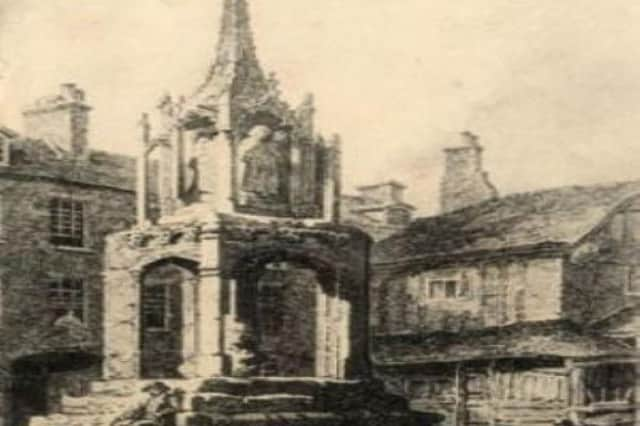Delving into the fascinating history of the Leighton Buzzard Market Cross


The Leighton Buzzard Market Cross was listed by the former Department of Environment as Grade II - of special interest and particular importance. The present cross dates from the 15th century. Given that a market has been held in Leighton Buzzard since at least 1086, and possibly back into the Anglo-Saxon period, it seems possible that the present cross replaces an older structure, but there is absolutely no evidence for it.
It echoes in architectural design the so called “Eleanor Crosses” built between 1291 and 1295 by Edward I as a memoral to the late Queen Eleanor of Castile. It is not impossible that aspects of the design for the Eleanor Crosses could’ve been copied for this one. Indeed the Cross in Geddington, Northamptonshire did become the site around which markets were held.
Advertisement
Advertisement
In 1950 Rev. S. John Forrest, Vicar of Leighton Buzzard, wrote an account of the cross called "The Story of Leighton Cross" a copy of which is in the parish archive [P91/28/14]. The Vicar noted that the cross has a pentagonal plan and that the height of the shaft is 27 feet. During the 15th century there was a cult of the five wounds of Christ on the cross and this may account for the five-sided plan.
In the upper storey of the canopy are five statues - Christ the King; the Virgin Mary with the infant Jesus; a Bishop, perhaps Saint Hugh of Lincoln, Leighton Buzzard being in the Diocese of Lincoln at that time; a King; Saint John the Baptist. At the restoration of 1851 the original medieval figures were replaced with replicas but these eroded more quickly than the originals and they were replaced in 1900.
By the 16th century there were two crosses in Leighton Buzzard. Sources in Bedfordshire and Luton Archives and Records Service mention a nether cross from 1537 to 1611 [KK26 and KK156]. The most obvious assumption is that it was in or near Church Square.Rev. Forrest, in his pamphlet, drew attention to the remarkable fact that during the Commonwealth Period (1649 to 1660) it was usual to destroy religious images and symbols yet not only as the market cross spared, it was actually repaired in 1650, using a four penny tax levy. The reason was, presumably, that it was a focus for civic life and for the reading of proclamations, banns and other important notices.
In 1851, £350 was spent on repairing the cross. The repairs included an ornamental stone parapet and iron railings erected all round. At this time the Lord of the Manor of Leighton Buzzard alias Grovebury claimed ownership of the cross as part of the market fixtures and fittings, like the Market House. A resolution was passed at the Easter Vestry of 1878 that the cross belonged to the Town Lands trustees, a charity administered by the parish officers. In 1894, however, the Lord renewed his claim and included the cross in the sale of the Stockgrove Estate. At the auction, however, the cross was withdrawn from sale and the Lord of the Manor, Sir Wyndham Hanmer, then wrote to the Town Lands Trustees conceding to them ownership of the cross.
Advertisement
Advertisement
By 1900 the cross was in a poor state and the Town lands Trustees undertook its restoration, including replacing the 1851 statues with the originals. The architect was G.F.Bodley who replaced the parapet with a different design, removed the railings and repaired the niches for the statues. The central pinnacle was restored in 1910.
Later 20th century restoration works were overseen by Leighton Buzzard architects H.A.Rolls and Partners working for the Leighton Buzzard Town Lands Trust and the Pettit Trust. The work began with the washing and cleaning of the structure in 1962 and 1963 at a cost of £350 [Z889/2/41/1]. The 15th century figures, the north outside pinnacle and other general masonry were repaired and restored between 1970 and 1972 [Z889/2/41/2].
In the 1980s a number of works were required. In 1980 it was necessary to clean the cross, removing graffiti on the piers and central column and apply an anti-graffiti solution. Erection of perimeter railings was also contemplated [Z889/2/41/3].
The final bill for the restoration works came to £2,282. The idea to erect railings was not particularly popular and the planning authority, South Bedfordshire District Council objected to the proposed height - 6 feet 3 inches - as being obtrusive and hiding the details of the cross from view. Eventually it was proposed simply to install infill railings around the arches. Initial plans in 1984 were not acceptable to South Bedfordshire District Council on the grounds of aestheticism and the Trustees erected a temporary wooden paling fence around the arches, meanwhile more vandalism occurred. Eventually in 1987 the railings were installed which remain at the time of writing.
Advertisement
Advertisement
For more details of Leighton Buzzard please see the Community Histories pages for Leighton Buzzard on Bedfordshire Archives website https://bedsarchives.bedford.gov.uk/Archives-Service.aspx. If you have any queries please email [email protected] or telephone 01234 228833.